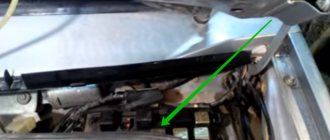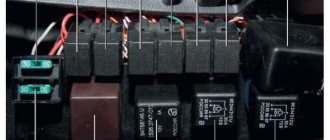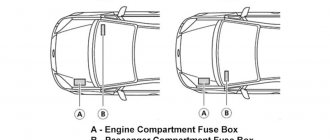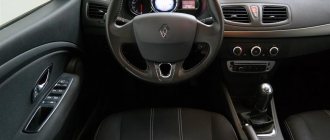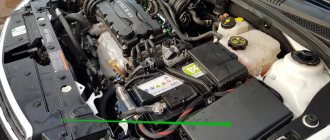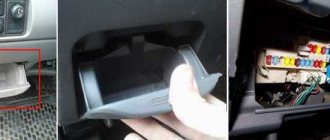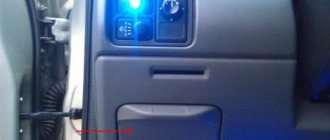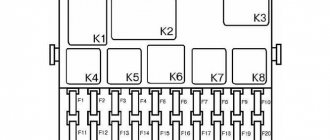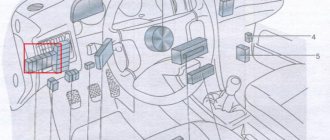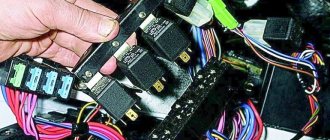City car Daewoo Matiz
produced in several generations and with various modifications in 1997, 1998, 1999, 2000, 2001, 2002, 2003, 2004, 2005, 2006, 2007, 2008, 2009, 2010, 2011, 2012, 2013, 2014, 20 '15 mainly with small cars engine volumes
0.8 and 1.0 liters. In this material you will find a description of the fuse and relay blocks of the Daewoo Matiz , their locations, diagrams and photographs. Let's highlight the fuse responsible for the cigarette lighter and answer the most frequently asked questions.
Fuses and relays under the hood of Daewoo Matiz
The mounting block of fuses and relays under the hood of the Daewoo Matiz is located on the driver's side, near the battery and fender.
Fuse and relay box diagram in the engine compartment of Daewoo Matiz
Description of the fuses of the mounting block in the engine compartment
| Number | No. in photo | Denomination | Purpose of fuses |
| Ef1 | 1 | 50 | ABS (optional) |
| Ef2 | 2 | 40 | All consumers powered regardless of the position of the key in the ignition switch (constant power) |
| Ef3 | 21 | 10 | Fuel pump (10A) or Fog lights (15A) |
| Ef4 | 20 | 10 | Power supply to the ECU from the ignition switch, fuel pump relay winding, ABS unit (optional), generator pre-excitation (at start-up), terminal “B” of the ignition coil unit, speed sensor |
| Ef5 | 19 | 10 | Reserve |
| Ef6 | 18 | 20 | Electric heater fan |
| Ef7 | 17 | 15 | Tailgate glass heating element |
| Ef8 | 16 | 10 | High beam right headlight |
| Ef9 | 15 | 10 | Left high beam |
| Ef10 | 14 | 10 | Low beam right headlight |
| Ef11 | 13 | 10 | Low beam left headlight |
| Ef12 | 12 | 10 | Side light of the right headlight and right rear light |
| Ef13 | 11 | 10 | Side light of the left headlight, left rear light and license plate lights |
| Ef14 | 10 | 10 | A/C compressor clutch (optional) |
| Ef15 | 9 | 30 | Electric cooling fan |
| Ef16 | 8 | 10 | Reserve |
| Ef17 | 7 | 10 | Sound signal |
| Ef18 | 6 | 20 | Power supply for headlight relay, headlight high beam switch |
| Ef19 | 5 | 15 | Continuous power supply to the ECU, main relay coil, air conditioning compressor clutch relay coil, high speed cooling fan relay coil, low speed cooling fan relay coil, oxygen concentration and camshaft position sensors, fuel injectors, exhaust gas recirculation and canister purge valves , fuel pump relay power supply |
| Ef20 | 4 | 15 | Fog lights |
| Ef21 | 3 | 15 | Reserve |
Description of the mounting block relay in the engine compartment
| Number | Name | Purpose |
| K1 | Cooling Fan High Speed Relay | Electric cooling fan (high speed) |
| K2 | Main relay | ECU, A/C compressor clutch relay coil, high speed cooling fan relay coil, low speed cooling fan relay coil, oxygen concentration and camshaft position sensors, fuel injectors, exhaust gas recirculation and canister purge valves |
| short circuit | Heater fan and tailgate defroster relay | Heater fan operating mode switch, tailgate glass heating element switch |
| K4 | Fog light relay | Fog lights |
| K5 | Fuel pump relay | Fuel pump |
| K6 | Horn relay (optional) | Sound signal |
| K7 | Cooling Radiator Fan Low Speed Relay | Cooling fan (low speed) |
| K8 | Head light relay | Headlights |
| K9 | Outdoor lighting relay | Side light, instrument cluster illumination |
| K10 | A/C compressor relay | A/C compressor clutch (optional) |
Relay functions
The fuel pump relay performs a number of important functions, thanks to which, including the ignition of the Daewoo Matiz, the system starts working.
So, it helps to do the following:
- Ensure stable operation of the fuel pumping mechanism;
- Immediately start the fuel injection nozzles when turning the ignition key;
- Limits engine speed when necessary.
Thus, when starting the car, the fuel pump relay activates the fuel pumping unit for a couple of seconds to create the required level of pressure in the lines. If it is necessary to adjust the engine speed, this unit will turn off or turn on the fuel pump in time.
Fuel pump relay Daewoo Matiz
Fuse box Daewoo Matiz
Home • Daewoo • Matiz • Electrics
There are two mounting blocks of fuses and relays on the Deo Matiz car, one is located in the engine compartment, and the second is in the passenger compartment.
Placement of fuses and relays in the interior of Deo Matiz
Deo Matiz mounting block located in the passenger compartment: F1—F14 — fuses; 1 — windshield wiper relay; 2 - relay for direction indicators and hazard warning lights; 3 — rear fog lamp relay; 4 - audible speed warning light.
Placement of relays and fuses in the engine compartment of Deo Matiz
Placement of fuses on the fuse and relay box located in the Matiz engine compartment: Ef11—Ef21 — fuses; 1 - high speed radiator fan relay; 2 - main relay; 3 - ignition relay; 4 - front fog lamp relay; 5 - low speed radiator fan relay; 6 — backlight relay; 7 - air conditioner relay; 8 - headlight relay; 9 - sound signal relay.
Replacing fuses on Deo Matiz
Always replace the fuse with another fuse of the same capacity. Each fuse is marked with its rated current. Do not replace a fuse more than once without determining the cause of its blown. If the fuse is blown, it means that the conductor connecting the fuse contacts is broken.
Install a new fuse rated for the same amperage. The amount of current protected is indicated on the back of each fuse. If the installed fuse has blown again, check the electrical circuit protected by the fuse. Do not replace the fuse with a jumper wire as this may seriously damage the vehicle's electrical circuit.
The circuits protected by fuses are shown in the table below.
Decoding the mounting block of Deo Matiz fuses
| Fuse designation | Current, A | Source | Protected Circuits |
| Daewoo Matiz fuse diagram in the fuse and relay box in the engine compartment | |||
| Ef2 | 40 | Accumulator battery | Ignition switch, control panel fuse box (F11-F13) |
| Ef3 | 10 | Accumulator battery | Fuel supply switch (inertia switch) |
| Ef4 | 10 | Ignition 1 | Fuel, generator, speed sensor, fuel pump relay, main relay, ignition coil |
| Ef5 | — | — | Not used |
| Ef6 | 20 | Accumulator battery | Heater fan motor |
| Ef7 | 15 | Accumulator battery | Rear window defroster |
| Ef8 | 10 | Accumulator battery | High beam headlights, right side |
| Ef9 | 10 | Accumulator battery | High beam headlights, left side |
| Ef10 | 10 | Accumulator battery | Low beam headlights, right side |
| Ef11 | 10 | Accumulator battery | Low beam headlights, left side |
| Ef12 | 10 | 58 | Tail lights and lighting, right side |
| Ef13 | 10 | 58 | Tail lights and lighting, left side |
| Ef14 | 10 | Accumulator battery | Air conditioning compressor |
| Ef15 | 30 | Accumulator battery | Radiator fan |
| Ef16 | 10 | Spare | |
| Ef17 | 10 | Accumulator battery | Sound signal |
| Ef18 | 20 | Accumulator battery | Headlight relay, high beam switch |
| Ef19 | 15 | Accumulator battery | Electronic control unit, main relay |
| Ef20 | 15 | Accumulator battery | Front fog lights |
| Ef21 | 15 | Spare | |
| Fuse diagram located in the fuse and relay box in the Deo Matiz interior | |||
| F1 | 10 | Ignition 1 | Instrument panel, clock |
| F2 | 10 | Ignition 1 | SDM |
| F3 | 25 | Ignition 1 | Hazard light switch |
| F4 | 10 | Ignition 1 | Turn signal lamps |
| F5 | 15 | Accumulator battery | Stop signal |
| F6 | 10 | ACC ignition | Audio system |
| F7 | 20 | ACC ignition | Cigarette lighter |
| F8 | 15 | Ignition 2 | Wiper |
| F9 | 15 | Ignition 2 | Rear wiper motor, front and rear windshield washers, reversing light |
| F10 | 10 | Ignition 2 | Electric exterior mirrors |
| F11 | 10 | Ef2 | Audio system, interior lighting |
| F12 | 15 | Ef2 | Hazard light, clock |
| F13 | 20 | Ef2 | Electric door locks |
| F14 | 20 | Starter | Starter motor |
Daewoo Matiz fuses: purpose and location
Fuse blocks in Daewoo Matiz protect on-board electronics from overload and short circuits. These elements are located in the cabin and under the hood. Accordingly, depending on its location, each fuse box is responsible for maintaining the operation of various on-board devices.
Matiz protection device
Installing fuses on Daewoo Matiz is a mandatory procedure, without which the car will not be released from the assembly line. The absence of these components in the design of the machine will quickly lead to irreparable consequences. Fuse boxes must be located in the vehicle because these elements protect on-board power systems and equipment from overloads and short circuits.
These components on Daewoo Matiz are able to indicate the presence of a problem in advance (before the built-in devices fail). If the car's fuses constantly blow, then it is necessary to send the car to a service station to check the condition of the on-board equipment. The frequent occurrence of such problems indicates the presence of a break in the wiring or other, no less dangerous faults.
Placing Blocks
Daewoo Matiz has such blocks in the engine compartment and interior. Such a part contains several fuses, each of which is placed in a specific place. In particular, Daewoo Matiz blocks provide places for installing protective elements:
- anti-lock braking system;
- heater fan;
- high beam;
- radiator fan and others.
Additionally, spaces are provided for relays connected to the corresponding vehicle components. More detailed information about where these blocks are located and the markings of fuses should be specified in the instructions for Deo Matiz.
In the cabin
To get to the fuse box in the cabin, you will need to sit in the passenger seat. Next, you need to lean towards the driver’s seat, thereby providing an overview of the area that is located under the dashboard. Then you need to turn your head towards the pedals. Then the required element will open, to which the standard radio and other equipment are connected.
You can also get to this fuse box from the street by opening the driver's door and squatting down to look under the instrument panel.
Description of the cabin unit
In addition to the cigarette lighter on the Matiz, cabin fuses protect:
- Instrument panel (marked as F1 or 10A). This element is connected to the immobilizer, clock, alarm, sensors and warning lights.
- Airbag (F2 or 10A).
- Electric windows (F3 or 25A).
- Turn signal indicators (F4 or 10A). This element is also connected to the corresponding lamp on the dashboard.
- Brake lights (F5 or 15A).
- Head unit (F6 or 10A).
- Front windshield wipers (F8 or 15A).
- Rear wiper (F9 or 15A). The reverse lamp and washers are also connected to this fuse.
The remaining sockets are respectively intended for the protection elements for the electric drive of the side mirrors, audio system and interior light, power supply for the alarm system, central locking, and starter traction relay.
Relay unit in the cabin
Also in the block on the Daewoo Matiz there are separate sockets for connecting additional fuses and relays. The latter provide work:
- front windshield wiper;
- turn signals;
- alarm;
- rear fog lamp.
Problems with the relay are determined “by ear”. If, after turning on the indicated components, clicks do not occur in the block under the dashboard of the Daewoo Matiz, then the fault lies precisely in these parts.
Under the hood
The second unit on the Daewoo Matiz is located under the hood on the left next to the battery. This arrangement simplifies repair work caused by failure of protection elements.
Daewoo Matiz
In this case, eliminate the short circuit. There may also be a break or short circuit in the wiring running from the headlights to the trunk. F6 10 A - radio tape recorder. Standard Clarion radio. Usually the radio turns on only when you turn the key of the Daewoo Matiz, turn signal diagram 1 or 2 position 2 - ignition.
If your radio stops turning on when you turn on the ignition, check this fuse and the contacts in its socket.
Measure the voltage in the radio connector by disconnecting it. If the voltage of 12 V comes there and the contacts of the Daewoo Matiz turn signal connector, most likely the problem is inside the radio itself - either its power switch has broken, or the contact inside on the board has disappeared, or one of its components has failed. If there is no voltage at the connector, check the wiring to the fuse, as well as the presence of voltage at it.
F7 20 A - cigarette lighter.
Wiring diagrams Daewoo Matiz
If the cigarette lighter stops working, first check the fuse. Due to the connection of different connectors of devices to the cigarette lighter at different angles, a short circuit may occur in the Daewoo Matiz turn signal circuit, which is why the fuse blows.
If you have an additional 12 V connector, connect devices. Also check the wiring from the cigarette lighter to the fuse. F8 15 A - windshield cleaner.
Apply 12V to the purifier motor and check if it works. If it fails, replace it with a new one. Inspect its brushes, clean them or replace them with new ones if contact is poor. Also check the wires from the engine to the steering column switch, from the relay to ground, from the fuse to the relay and from the fuse to the power source. Also check the wiper mechanism, trapezoid and Daewoo Matiz turn signal diagram, wiper mounting nuts.
F9 15 A - rear window wiper, front and rear washers, reversing lamp.
If your windshield and rear window washer does not work, Daewoo Matiz turn signal diagram, fluid level in the washer reservoir.
Located at the bottom of the right headlight. To get to it, you will most likely need to remove the Daewoo Matiz turn signal diagram. In order not to remove the headlight, you can try to crawl up from below with the wheels turned out and the right wheel liner removed. At the bottom of the tank there are 2 pumps - for the windshield and rear windows. Apply 12 V voltage directly to one of the pumps, thereby checking its serviceability.
Another way to check is to swap the terminals to the two pumps, since one of the pumps is most likely working. If you find a fault in the pump, replace it with a new one.
If the washer stops working in winter, make sure that antifreeze fluid is filled in, check the system channels for blockages and freezing of the fluid, and also check the nozzles from which the fluid gets onto the glass.
Another problem may be in the steering column switch; check the contact in it that is responsible for the operation of the washers. If the rear washer does not work, but the front one works and the pumps are working properly, most likely the problem is a break in the fluid supply tube to the rear door or its connections in the system. The rear washer pipe connections are located in the front bumper, in the rear door corrugation and inside the rear door. If the tube breaks in the area of the rear door, to replace it you need to remove the trim of the Daewoo Matiz turn signal diagram and the rear part of the cabin.
First, it is better to remove the corrugation between the door and the body and check the integrity of the tube in this place.
A broken tube can either be repaired by cutting off the problem area and reconnected, or replaced with a new one. If the reversing light does not work, check the lamp and the contacts in its connector. If the lamp is intact, most likely the problem is in the reverse switch, which is screwed into the gearbox. You can get there from the Daewoo Matiz hood turn signal diagram by removing the air filter. The reverse sensor is screwed into the gearbox from above. The sensor closes the contacts when reverse gear is engaged. If it fails, replace it with a new one.
A frequent and unpleasant question: why does the fuel pump fuse blow out? Many, faced with this problem, begin to chaotically look for new fuses and insert the first one they come across. In such a situation, it is not always possible to find exactly the right fuse.
Having installed a new element, the car drives several tens of meters and stops again. At the same time, during these meters traveled, the car manages to shake and shake quite a bit.
The very name “fuse” indicates that this small element protects a more expensive device from failure. If the fuse blows, then the problem may lie in something more serious. Therefore, you should not insert another element instead of the desired one. The fuse consists of thin plates made of a certain material and they are of a fixed thickness.
A fusible element is soldered between the set of plates, which opens the circuit when overloaded. This entire structure is enclosed in a polymer mandrel.
The main reason for a blown fuse
Why the fuel pump fuse blows must be disassembled starting with the electrical wiring. It is the vehicle wiring that often causes the fusible element to fail. Overloading the wiring can short circuit a specific device, and in this case it is the fuel pump.
The cause of conduction-related failure may also be the constant presence of moisture in contact with the electrical circuit. Moisture leads to oxidation of contacts, which causes an increase in current in the circuit due to the increasing resistance of the oxidized contact.
Each fuse is designed for a specific current in the circuit. The current strength is marked on them. It can be calculated for the protective element by dividing the 220 V power of the device. It is also possible that a breakdown or break in the wire occurred somewhere, and it breaks through to ground.
To check the electrical wiring system, you need to “ring” it or examine it using a multimeter.
It also happens that the fuse looks like new, but there are problems with the fuel pump. This may be due to poor contact of the protection element with the terminals or a complete lack of contact.
Checking the performance of the fuel pump
Let's say you replaced the fuel pump fuse with a new one, and after a couple of minutes it failed again. Here you need to get serious and remove the fuel pump from the car. Separately from the car, we check the device for its correct operation. It also happens that the fuel pump itself does not work correctly (see the article “Signs of a fuel pump malfunction”). Then the problem is found, we change the fuel pump and everything is ready. If it works as expected, we check the wiring without the pump. Most often, our craftsmen install “bugs” instead of fuses.
Such a bug could be a moment, a paper clip or a wire. Naturally, this solution to the problem is not entirely correct - it does not solve the very essence, but only prevents the chain from constantly breaking. An installed “bug” can cause the fuel pump itself to burn out - a blown fuse is already a consequence of the problem.
Also, this repair approach can cause the electrical circuit to overload and cause a fire.
In this case, due to one non-working fuse, you also get a non-working car. But there are situations in which you cannot do without such a homemade element of protection.
Let's say you went somewhere far away, and a fuse burns out on the road. Then instead insert foil (cigarettes and chocolates contain it) or one thin strand of wire. In this case, it will help to get to the store and buy a normal one.
Perhaps after reading this text you will be able to fix the problem. In this article we looked at the topic: why does the fuel pump fuse blow? Unfortunately, failure of fuses to operate is a fairly common failure.
Daewoo Matiz is notable for its low cost and therefore attracts beginners and women. There are no complaints about the assembly of the car, but the electrical system has some shortcomings. If it happens that one of the electrical appliances stops working, then you should not panic. It is enough to use the information from this article. It describes the design of the components that are responsible for the safety of the Daewoo Matiz electrical system. The information below will help you find and fix problems as quickly as possible.
Replacement: step-by-step instructions
The power supply system on the Daewoo Matiz, like most cars, has a combined layout - there are 2 blocks with fuses located in the cabin and engine compartment.
To replace faulty elements, you will need no more than 15 minutes of free time, as well as the presence of a flat-blade screwdriver and tweezers - the whole process is performed as follows:
- First you need to disconnect all terminals on the car battery;
- Next, we find a fuse block in the engine compartment - it will be located on the right side of the power unit. Using the thin tip of a slotted screwdriver, unclip the plastic pistons and remove the cover from the fuse box;
- Then we look for the faulty element and, using ordinary tweezers or a specialized puller, remove the blown fuse;
- Fuses are installed by lightly pressing the part onto the socket until a characteristic click is heard. If there is carbon deposits or traces of oxidation on the landing cell, it would be a good idea to eliminate the defects with a coarse brush;
- If, when inspecting the engine compartment fuse box, no faulty elements were found, we move on to the interior. Inside the car, the unit is located in the area of the driver’s left foot - to dismantle it you will have to remove the protective plug;
- After searching and replacing faulty components, we connect the battery back and test all the functions of the car with the engine running.
However, if the fuses in the car regularly blow out, you need to go to a service station for diagnostics - it is quite possible that the generator in the car has unstable operation or there is a breakdown or weak contact in the electrical circuit.
Remember, you shouldn’t skimp on fuses - the safety and service life of your car directly depends on their performance!
Fuses and relays Daewoo Nexia N150
Most electrical circuits are protected by fuses. Powerful consumers (headlights, cooling system fan motor, electric fuel pump, etc.) are connected via a relay. The information is relevant for Daewoo Nexia 2008, 2009, 2010, 2011, 2012, 2013, 2014, 2015, 2022 models.
Fuses and relays are located in the mounting block.
To access the mounting block, remove the protective cover in the instrument panel.
On the inside of the mounting block cover there is a diagram of the location of fuses and relays installed on the outside of the block. The rating of the fuses, the circuits they protect and the purpose of the relay are given in the tables.
Location of fuses and relays on the outside of the mounting block
Location of fuses and relays on the inside of the mounting block
| Purpose of the relay in the mounting block | |
| Relay number | Relay purpose |
| K1 | Cooling Fan (High Speed) |
| K2 | Direction indicators. |
| K3 | Fuel pump. |
| K4 | Fog lights. Rear fog lights. |
| K5 | Side lights, fog lights. |
| K6 | Headlights. |
| K7 | Cooling fan (low speed). |
| K8 | Air conditioning compressor clutch. |
| K9 | Sound signal. |
| K10 | Headlights. |
| K11 | Melodious signal. |
| K12 | Turning on the 4th speed heater fan. |
| K13 | Ignition system. |
| K14 | Windshield cleaner. |
| K15 | Rear window heating timer. |
| Circuits protected by fuses | ||
| Fuse designation (see photo) | Rated current, A | Protected Circuits |
| F1 | 10 | ECU (battery circuit). |
| F2 | 10 | Side lamps, license plate lights, instrument cluster and control lights. |
| F3 | 15 | Ignition system relay circuit. |
| F4 | 20 | High beam headlight lamps. |
| F5 | 10 | Low beam lamp of the left headlight. Electric drive for adjusting the direction of the light beam of the left headlight. |
| F6 | 10 | Low beam lamp for the right headlight. Electric drive for adjusting the direction of the light beam of the right headlight. |
| F7 | 30 | Electric fuel pump, fuel injectors. |
| F8 | 20 | Turn indicators, brake lights. |
| F9 | 30 | Windshield cleaner. |
| F10 | 10 | Fuel tank filler flap drive. |
| F11 | 10 | Relay for turning on the electromagnetic clutch of the air conditioning compressor. |
| F12 | 30 | Cooling fan motor (low speed). Heater fan. |
| F13 | 20 | Reversing lamps. Generator excitation circuit. Instrument cluster, cigarette lighter, melodic sound signal, clock. |
| F14 | 30 | Sound signal. Cooling fan (high speed). |
| F15 | 20 | Alarm. Interior lamp. Trunk light bulb. |
| F16 | 30 | Window lift motor gearboxes. |
| F17 | 10 | Audio system (circuit from ignition switch). |
| F18 | 30 | Trunk lid lock control. Rear window heating timer. Central locking. Audio system (battery circuit). |
| F19 | 30 | Heater fan 4th speed relay. |
| F20 | 30 | Fog lights. |
Video
City car Daewoo Matiz
produced in several generations and with various modifications in 1997, 1998, 1999, 2000, 2001, 2002, 2003, 2004, 2005, 2006, 2007, 2008, 2009, 2010, 2011, 2012, 2013, 2014, 20 '22 mainly with small cars engine volumes 0.8 and 1.0 liters. In this material you will find a description of the fuse and relay blocks of the Daewoo Matiz, their locations, diagrams and photographs. Let's highlight the fuse responsible for the cigarette lighter and answer the most frequently asked questions.
How to determine the malfunction?
One of the most common wiring problems is current leakage.
As a rule, the diagnosis of such a malfunction is carried out using the negative terminal from the battery, while the positive terminal must remain connected:
- The tester (multimeter) needs to be connected with one probe to the negative terminal of the battery, and the second probe is connected to the removed terminal block. When connected, values should appear on the tester screen - the optimal indicator in this case is a current in the region of 15-70 mA, this parameter depends on the number of voltage consumers connected to the battery. If we are talking about a car with a carburetor engine, equipped with basic equipment and without an anti-theft system, then the leakage current will be small.
- If the diagnostics show that the leakage readings are within the normal range, then the battery needs to be diagnosed. If the current consumption is increased, then the check continues, now we work with the fuse block. The safety elements are removed from this device, and after each is removed, the leakage is measured.
- If it happens that after removing the fuse, the leakage rate decreases to the optimal level, this indicates that the circuit with the fuse removed is consuming more current. Now you only need to find out which consumers are connected to this section of the electrical circuit, after which the wiring itself is diagnosed (Video author - Alexander Shestopalov).
If the battery is faulty, energy consumers may not work at full capacity, and if the battery is completely discharged, then the engine will not be able to start. It is necessary to diagnose the battery from time to time - check its voltage, measure the level and density of the electrolyte in the jars, and inspect the case. If there are cracks in the case, it is possible that electrolyte is leaking out of them, which contributes to the destruction of the battery.
You also need to pay attention to diagnosing the performance of the generator unit. If this device is not working properly, it will not be able to charge the car battery when the engine is running.
To diagnose the generator, you will need a tester - a multimeter; you need to switch it to ohmmeter mode, and then perform the following steps:
- The tester probes are connected to the battery observing polarity.
- The engine starts, after which it is necessary to set the crankshaft rotation speed to medium, turn on the music and optics. This way you can create operating conditions for the motor, under which the battery voltage is measured.
- After this, it is necessary to take readings from the tester. If the generator unit is in working condition, the voltage parameter at the battery terminals should be about 13.5-14.5 volts. If this value is lower, then the device needs to be checked in more detail (video author - Dmitry Pristrom).
Ignition system
The contactless ignition system of the Daewoo Nexia works stably and there are no outright complaints about it. In the event that all elements are serviced and checked for mechanical integrity in a timely manner. First of all, this applies to highly loaded devices:
- ignition distributor;
- coils;
- high voltage circuit;
- electronic control unit.
Since 2008, an ECU without feedback has been installed on the car, so its operation has become more stable. In addition to all other corrective functions, the ECU also controls the operation of the ignition system. The control unit adjusts the operation of the system based on the following data:
- crankshaft rotation speed;
- throttle opening angle;
- data from the catalytic converter oxygen sensor;
- temperature and pressure of incoming air.
The ignition system must quickly respond to ECU signals and make adjustments to the advance angle. In case of any abnormal readings, the system informs the driver about the need for maintenance or repair.
Thus, any faults in the electrical equipment of the Daewoo Nexia can be localized, and the diagram posted on the page will help with this. Control the on-board voltage, and have a good trip!
Auto-assistance
The Daewoo Matiz passenger car can be equipped with one or two wipers (windshield wipers) designed to clean the windshield and rear windshield. In operation, they are turned on by the right one under the steering switch, but the electric motors of the front and rear wiper gearboxes receive power through different fuses. In addition, Daewoo Matizs in the STD configuration have a simplified circuit for switching on the front wipers, operating in only two modes, low and high speed of movement of the brushes, and they do not have an intermittent operating mode.
When the windshield wiper refuses to turn on in all operating modes, you first need to check the condition of fuse F8 (15A), located in the mounting block of the car interior, which is located under the front panel in the area where the driver’s left foot is located. If fuse F8 has not blown and its contacts are not oxidized, then, using the replacement method, you need to check the serviceability of the wiper switch relay installed in the same mounting block.
It is possible that the same malfunction can be caused by failure of the steering switch or electric motor of the gearmotor, whose graphite commutator brushes are stuck or worn out, or a short circuit in the armature winding has occurred. The wiper motor may not work due to corrosion in the contacts of connector C205, through which voltage is supplied to the gear motor block.
If the wipers do not turn on in only one of the operating modes, then troubleshooting should begin by checking the condition of the contacts under the steering switch, which are responsible for turning on this operating mode. If the switch is working properly, you will have to check the corresponding circuit from the contact block of the connector under the steering switch to the contact of the connector block of the electric motor. In the event of a failure in the intermittent mode of switching on the wipers, troubleshooting should begin by checking the condition of the relay.
Troubleshooting for which the rear wiper refuses to turn on begins with checking fuse F9 (15A), located in the same mounting block as fuse F8. If fuse F9 has not blown, then you will have to check whether voltage is supplied to contacts 1 and 2 of the rear wiper motor when it is turned on. If there is no voltage, then you need to see if the wires in the corrugation are broken when moving from the body to the rear door. If there is voltage, you will have to check the rear wiper motor.
Reasons for failure
The fuel pump on Daewoo Matiz cars stops functioning properly for some reason. Among them are found:
- Wear of elements from time or use;
- Damage caused by mechanical means;
- Short circuit or voltage drops in the wiring;
You can tell that the relay is faulty just by the appearance of the device. If burnt metal contacts are visible, while no voltage was supplied to the connectors. When you are sure that this particular part has failed, you need to replace it.
What are fuses and what are they for?
An electrical fuse performs a special protective function in an electrical circuit. Fuses are not installed on the most important systems of the car, such as the engine or gearbox elements. Without diagrams and tables, it is very difficult to navigate the mounting block. Sometimes a single electrical fuse is responsible for several systems simultaneously
The fuses of primary importance are located directly in the block, which is located under the hood of the Daewoo Matiz
The very word “fuse” already suggests that this small device is necessary to protect electrical circuits from possible short circuits and possible overloads that may occur during the operation of the car.
The fuse is connected in series in the electrical circuit; therefore, if it blows, the driver must pay special attention to this. If the same electrical fuse has blown twice in a row, then it is imperative to identify the reason for this behavior of the device, study the location of the fuses on the Daewoo Matiz and eliminate the malfunction
Has a function stopped working?
It performs protective functions in the electrical circuit. Fuses are not installed on major vehicle components such as the engine or transmission components. Without special tables and diagrams, understanding the mounting block is not so easy. Most often, one fuse is responsible for several functions and systems at once. The main fuses are located in the mounting block, which is located under the hood.
The main thing to remember is that you can only replace a fuse with a fuse with exactly the same power. Tables of Daewoo Matiz fuse decoding will help you figure it out and identify the cause of the breakdown. You can find the rated current value on any fuse. How can you determine whether the fuse has failed or not? Take a close look at it. There is a thin conductor between the contacts. So, if the fuse burns out, this conductor must be broken, so do not rush to change it without establishing the cause of the malfunction.
Often car owners are faced with a situation where, after replacing a fuse, it burns out again. In this case, it is necessary to check the functionality of the electrical circuit.
We remind you that the main fuses are located in the mounting block, the diagram of which is shown below.
Placing Blocks
Daewoo Matiz has such blocks in the engine compartment and interior. Such a part contains several fuses, each of which is placed in a specific place. In particular, Daewoo Matiz blocks provide places for installing protective elements:
- anti-lock braking system;
- heater fan;
- high beam;
- radiator fan and others.
Additionally, spaces are provided for relays connected to the corresponding vehicle components. More detailed information about where these blocks are located and the markings of fuses should be specified in the instructions for Deo Matiz.
Replacement: step-by-step instructions
The power supply system on the Daewoo Matiz, like most cars, has a combined layout - there are 2 blocks with fuses located in the cabin and engine compartment.
To replace faulty elements, you will need no more than 15 minutes of free time, as well as the presence of a flat-blade screwdriver and tweezers - the whole process is performed as follows:
- First you need to disconnect all terminals on the car battery;
- Next, we find a fuse block in the engine compartment - it will be located on the right side of the power unit. Using the thin tip of a slotted screwdriver, unclip the plastic pistons and remove the cover from the fuse box;
- Then we look for the faulty element and, using ordinary tweezers or a specialized puller, remove the blown fuse;
- Fuses are installed by lightly pressing the part onto the socket until a characteristic click is heard. If there is carbon deposits or traces of oxidation on the landing cell, it would be a good idea to eliminate the defects with a coarse brush;
- If, when inspecting the engine compartment fuse box, no faulty elements were found, we move on to the interior. Inside the car, the unit is located in the area of the driver’s left foot - to dismantle it you will have to remove the protective plug;
- After searching and replacing faulty components, we connect the battery back and test all the functions of the car with the engine running.
However, if the fuses in the car regularly blow out, you need to go to a service station for diagnostics - it is quite possible that the generator in the car has unstable operation or there is a breakdown or weak contact in the electrical circuit.
Remember, you shouldn’t skimp on fuses - the safety and service life of your car directly depends on their performance!
conclusions
The Daewoo Matiz car is well protected from overloads in the on-board network by fuse links. But you should know that in many electrical circuits relays perform their functions in series. Since these elements are checked first, they are located in the appropriate block (interior or engine compartment). Their grouping is made taking into account a specific purpose, working in conjunction with the same end consumers.
The principles outlined above simplify troubleshooting when headlights, locks, or other components or units are not operating correctly. But in each case, an appropriate scheme is used, which implies the implementation of an optimal algorithm of actions. Not only the inserts and relays in the unit are checked, but also the contacts, wiring, mechanical and electronic components of the vehicle.
About the protection device
A fuse is a device that serves to protect against overloads in an electrical circuit. When operating the Daewoo Matiz, problems may occur in the electrical system:
- short circuit;
- overload.
The occurrence of an emergency situation will cause irreparable damage to electrical appliances of Daewoo Matiz.
If a fusible part (fuse) burns out, the driver needs to replace it and check the electrical system of the Daewoo Matiz for faults. If the fuse blows 2 times, then it is imperative to look for the cause and eliminate it. This will require specialized knowledge of vehicle wiring, including which parts of the system each fuse is responsible for.

